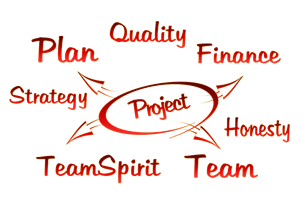Project management
A project is an individual or collaborative enterprise, possibly involving research or design, that is carefully planned, usually by the project assigned team, to achieve a particular aim. (Wikipedia)
Also can define a project as the response to a need, the solution to a problem. Further, it’s a solution that promises a benefit. A project is temporary in nature; that means that it has a specific start and finish. A project consists of a well-defined collection of small jobs (tasks) and ordinarily culminates in the creation of an end product or products (deliverable). There will be a preferred sequence of execution for the project’s tasks (the schedule).
Contributor:
Nurul Octaviana
What is project management?
Project management is the discipline of initiating, planning, executing, controlling, and closing the work of a team to achieve specific goals and meet specific success criteria. (Wikipedia)A project can be considered to be any series of activities and tasks that:
- Have a specific objective to be completed within certain specifications
- Have defined start and end dates
- Have funding limits (if applicable)
- Consume human and nonhuman resources (i.e., money, people, equipment)
- Are multifunctional (i.e., cut across several functional lines
Who uses project management?
A project manager:
- Engineering
- Construction
- IT
- Architecture
- Finance and Law
Why use project management?
Project management is designed to make better use of existing resources by getting work to flow horizontally as well as vertically within the company. This approach does not really destroy the vertical, bureaucratic flow of work but simply requires that line organizations talk to one another horizontally so work will be accomplished more smoothly throughout the organization.The potential benefits from project management are:
- Identification of functional responsibilities to ensure that all activities are accounted for, regardless of personnel turnover
- Minimizing the need for continuous reporting
- Identification of time limits for scheduling
- Identification of a methodology for trade-off analysis
- Measurement of accomplishment against plans
- Early identification of problems so that corrective action may follow
- Improved estimating capability for future planning
- Knowing when objectives cannot be met or will be exceeded
How many project management process groups are there?
Project management is the planning, organizing, directing, and controlling of company resources for a relatively short-term objective that has been established to complete specific goals and objectives.Project involves five process groups as identified in as identified in the PMBOK Guide:
Project initiation
- Selection of the best project given resource limits
- Recognizing the benefits of the project
- Preparation of the documents to sanction the project
- Assigning of the project manager
Project planning
- Definition of the work requirements
- Definition of the quality and quantity of work
- Definition of the resources needed
- Scheduling the activities
- Evaluation of the various risks
Project execution
- Negotiating for the project team members
- Directing and managing the work
- Working with the team members to help them improve
Project monitoring and control
- Tracking progress
- Comparing actual outcome to predicted outcome
- Analyzing variances and impacts
- Making adjustments
Project closure
- Contractual closure of the contract
- Financial closure of the charge numbers
- Administrative closure of the paperwork
- Verifying that all of the work has been accomplished
The Project Management Process :
- Identify and frame the problem or opportunity In this phase, the fundamental need is identified. The need is then quantified with respect to factors such as its size, shape, and extent.
- Identify and define the best project solution This step begins by identifying all reasonable alternatives. The team may use brainstorming or similar creativity techniques to help identify alternative solutions. Using criteria previously agreed upon, the team then singles out the “best” solution.
- Identify task and resource requirements. Once the project solution is identified, we’re ready to move to the next phase, which is to identify the task and the resource requirements. This is also referred to as scope management. In this step, the team identifies all of the work to be done (the tasks).
- Prepare the control schedule and resource allocation plan Creating the project schedule consists of several steps. First, a network or logic diagram is prepared to display the optimum sequencing of the tasks. Next, the length of time required to complete each task (its duration) is estimated.
- Estimate project costs and prepare a project budget. The project manager coordinates the preparation of a cost estimate for the project. A variety of methods may be used to estimate cost, depending upon the level of detail that exists at that time.
- Analyze risk and establish stakeholder relationships Identify and try to deal with anything that might pose a threat to the successful completion of the project. This is called risk management. In risk management, “high-threat” potential problems are identified. Action is taken on each high-threat potential problem, either to reduce the probability that the problem will occur or to reduce the impact on the project if it does occur.
- Maintain control and communicate as needed during During project execution, people are carrying out the tasks and progress information is being reported through regular team meetings. The team uses this information to maintain control over the direction of the project and takes corrective action as needed.
- Manage to an orderly close-out This step is often characterized by the development of a punch list. A punch list is a relatively small list of tasks that the project team needs to complete in order to close out the project. The project manager must keep team members focused at this critical time. Unfortunately, far too often the attention of the team begins to drift because the project is shutting down. If this step of the process is not managed in an orderly fashion, the end can have a tendency to drag on.



